Sending cold emails is not like sending regular emails.
Cold email is a digital outreach channel, just like social media or pay-per-click advertising:
- It’s scalable,
- It can be automated to a significant extent,
- It’s measurable and needs to be cost-effective.
But there are also some characteristics that make cold email unique. And you need a strategy and objectives adapted to this channel.
Your interim goal should always be to get a positive reply. That’s the best thing that can happen with a cold email. It’s a result of gaining the recipient’s attention and interest.
But that’s not specific enough.
In this article, I’ll present the WARM framework to help you set great objectives for your outreach campaigns; objectives which are:
- Well-defined
- Achievable
- Reciprocal
- Meaningful
But first, let’s explore the why behind this framework.
Goals for cold emails
Cold emails can and should be used as the first step in value exchange.
Value exchange happens when any items or services are exchanged between two parties. It often relates to sales, where you exchange your goods or services for money, but it can also relate to other types of transactions.
When you initiate the process of value exchange, your ultimate goal is to affect the behavior of your prospect – to make them take an action they wouldn't otherwise take.
For you as the initiating party, the process of value exchange doesn't start with the cold email – it starts with you identifying a prospect who might need the value you can provide.
But for the prospect, the cold email they receive is when the process starts.
Depending on what you're offering and what you want in return, the process of value exchange may differ.
Let's look at two examples:
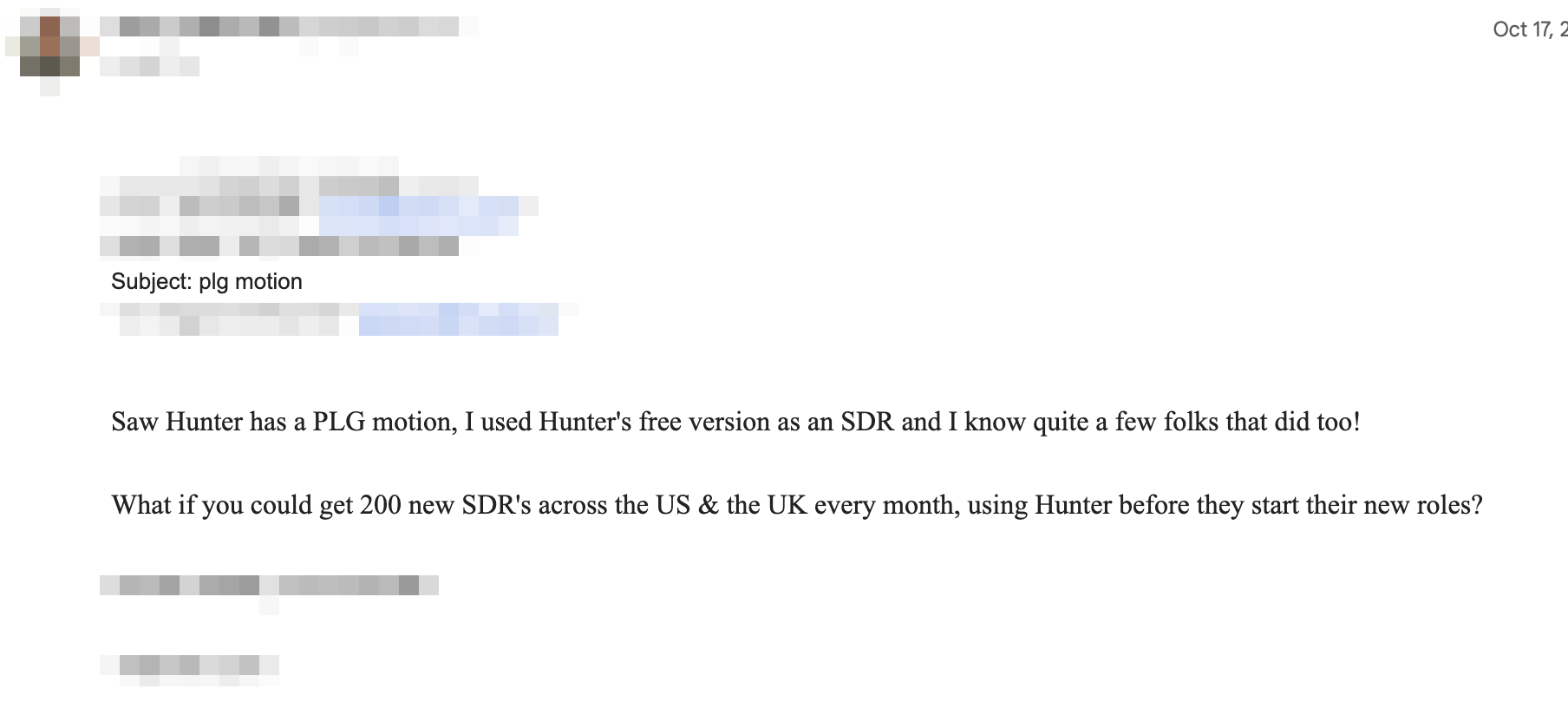
This message aims to prove that the sender understands how to provide a particular gain for the recipient: to get more people to use their product.
By establishing relevance and promising value for the recipient, the sender only tries to get a positive reply.
So this cold email only aims to initiate a relationship, grabbing the recipient's attention and interest so they feel compelled to reply.
Now, let's look at a different example:
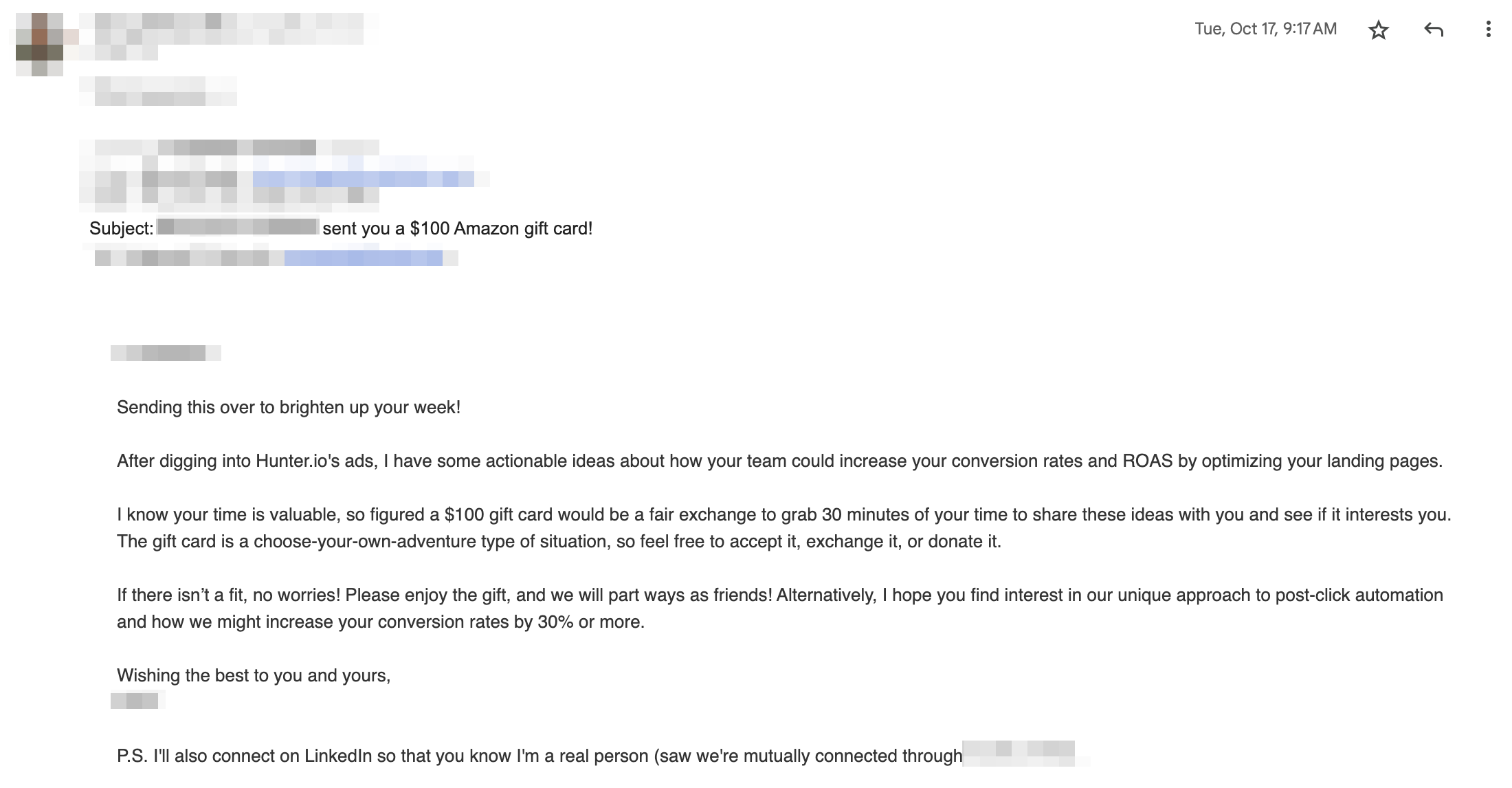
This email serves a broader purpose within the value exchange process.
It aims to inform the recipient of a potential opportunity but also seeks to get the recipient to agree to a meeting and provides monetary value in return. If it's successful, it would advance the process further than if the recipient replies.
This shows how you can use your cold emails to achieve different effects.
However, starting the process with an email is different than starting it with a real-life conversation.
Let's talk about the specific of cold emails that should determine the goals you set for your campaigns.
Why cold emails need WARM goals
Like any other channel, cold email has unique qualities:
Your recipient won’t always trust you
Many people perceive cold emails as somewhat intrusive. As you’re contacting your recipients for the first time, establishing trust and goodwill is part of your task.
It’s different on social media, where you intentionally create an account signed with your name, expecting people to know it and use it when contacting you.
You’re starting a personal relationship
If you can get a recipient to respond positively, you immediately start a personal relationship with them. You may not think about individual recipients when sending an automated campaign – at first, they may feel like a list of email addresses. But as soon as they reply, you must be ready to start a human conversation.
You’re asking your recipients to take action
You’re sending cold emails to get a positive reply or get your recipient to act in a different way. In other words, you’re just meeting someone and asking them to take action immediately – even if it’s as minimal as replying with a single word.
Your recipients can react in various ways
You don’t explicitly control your recipient’s next step. Some people may want to schedule a meeting immediately, some may want more information, and some will express objections. You have to be prepared to handle these reactions.
These characteristics of cold email may seem intimidating, but all they mean is that you need to set appropriate goals for your campaigns: objectives adapted to the channel.
WARM: a way to think about your cold email objectives
Cold emails may serve a variety of business purposes. But successful campaigns have something in common: they may be cold, but their objectives are WARM:
Well-defined
A well-defined goal means you can tell when your cold email is successful. It must be specific and measurable.
Let’s take an example. At Hunter, we’re looking for partners in our industry to co-market and build links.
A loose, unspecific goal for our outreach campaigns could be: “We want to send cold emails to websites in our industry, ask them if they want to collaborate on content, and get some positive responses."
A better version would be: "We want to build 10 links from high-authority, relevant websites. So we’ll:
- ask the recipients if they want to form a partnership,
- offer free access to our product in return so they can learn about our services, and
- receive at least a 10% response rate from recipients who are willing to form a marketing partnership."
The specific and measurable variant emphasizes the particular outcome we want to achieve: we want to get people interested in collaborating on link-building.
Achievable
Taking into account the interpersonality of cold emails and the associated low level of trust, we need to set campaign objectives that are realistic and achievable.
Someone you’ve never met before isn’t very likely to agree to a 30-minute call unless you can offer something meaningful in return. Your ask must be proportional to the value you provide and the relationship you manage to build.
The best way to think about it is to use a call to action that takes the least possible effort for your recipient.
Take a look at the example below:
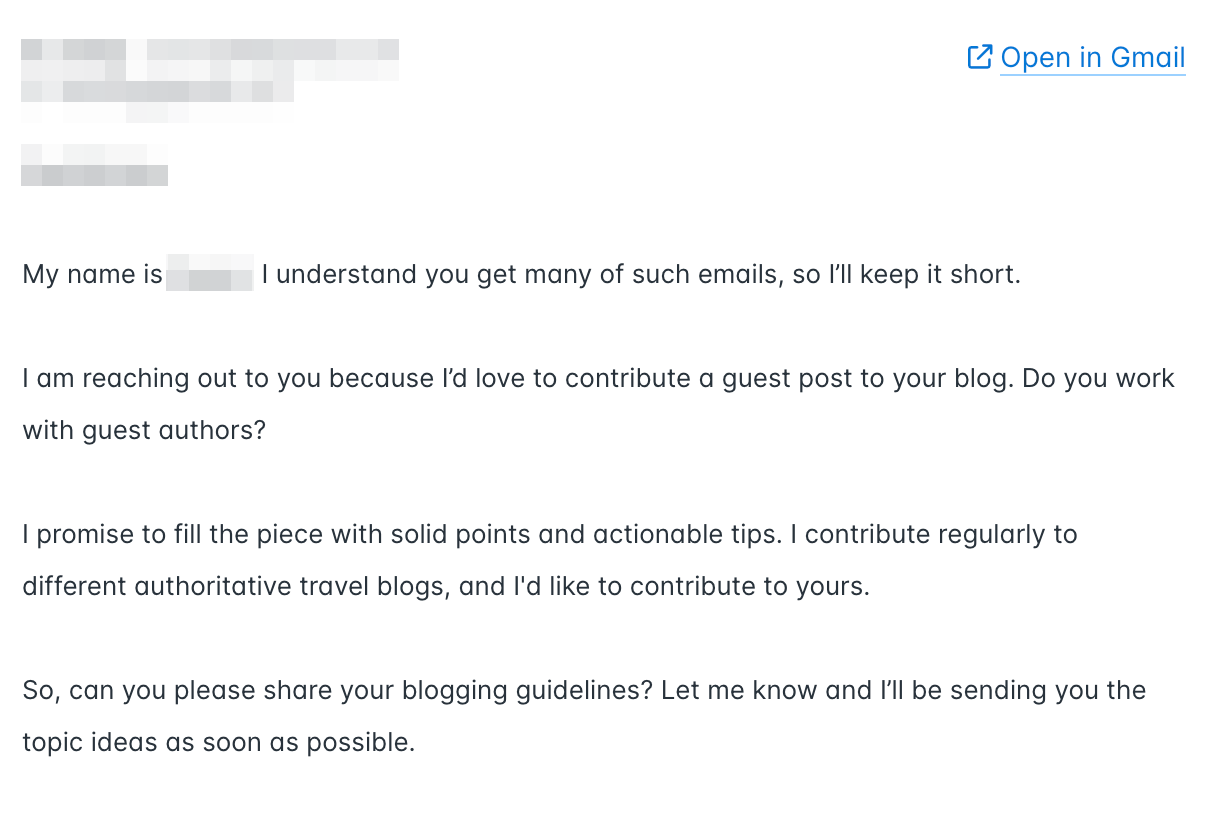
Without providing any upfront value for the recipient, the sender wants to get a green light and contribute to the recipient’s blog. Not only that, they’re also asking for the blogging guidelines in the very same message.
This message sets a goal for the entire campaign that’s very difficult to achieve.
Let’s use a contrasting example from Eric Nowoslawski:
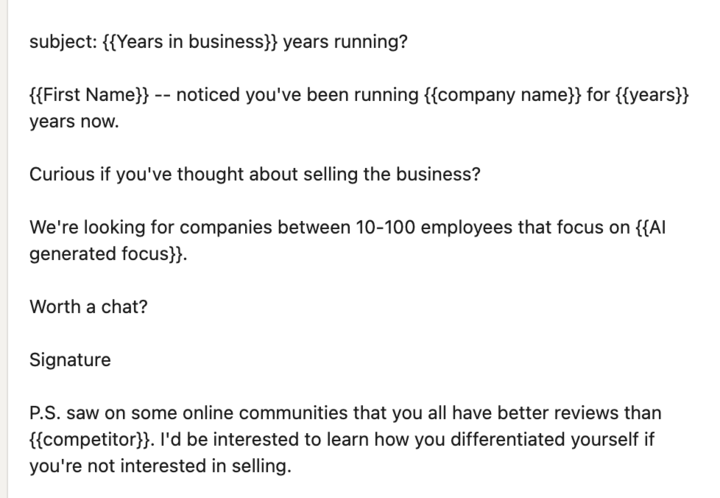
This campaign aims to find business owners willing to sell their businesses. Obviously, it's asking for fairly sensitive information, and many people won’t be ready to answer on the spot.
So to start a conversation, we can add an alternative call to action: a question many business owners would like to answer because it strokes their ego. With this tactic – rejection-then-retreat – you can improve your reply rate by giving the recipient an easier option. Furthermore, when you make a concession from your original request, the recipient feels obliged to return the "favor."
Reciprocal
Just responding to your email is an action your recipient has to take, and they have to feel it’s worth their time. It’s your responsibility to help your recipient before you expect them to return the favor!
This is where the rule of reciprocity is so useful.
Reciprocity means that in response to friendly actions, people are frequently much nicer and much more cooperative (...) It is a powerful method for gaining one's compliance with a request. The rule of reciprocity has the power to trigger feelings of indebtedness even when faced with an uninvited favor and irrespective of liking the person who executed the favor.
In other words, by doing someone a favor, even uninvited, you’re making it more likely that they will respond to your request.
What does this mean in practice?
You must provide something useful and valuable, either upfront or promising to deliver it if the recipient agrees.
Let’s use an example. I love this cold email shared by, again, Eric Nowoslawski on LinkedIn:
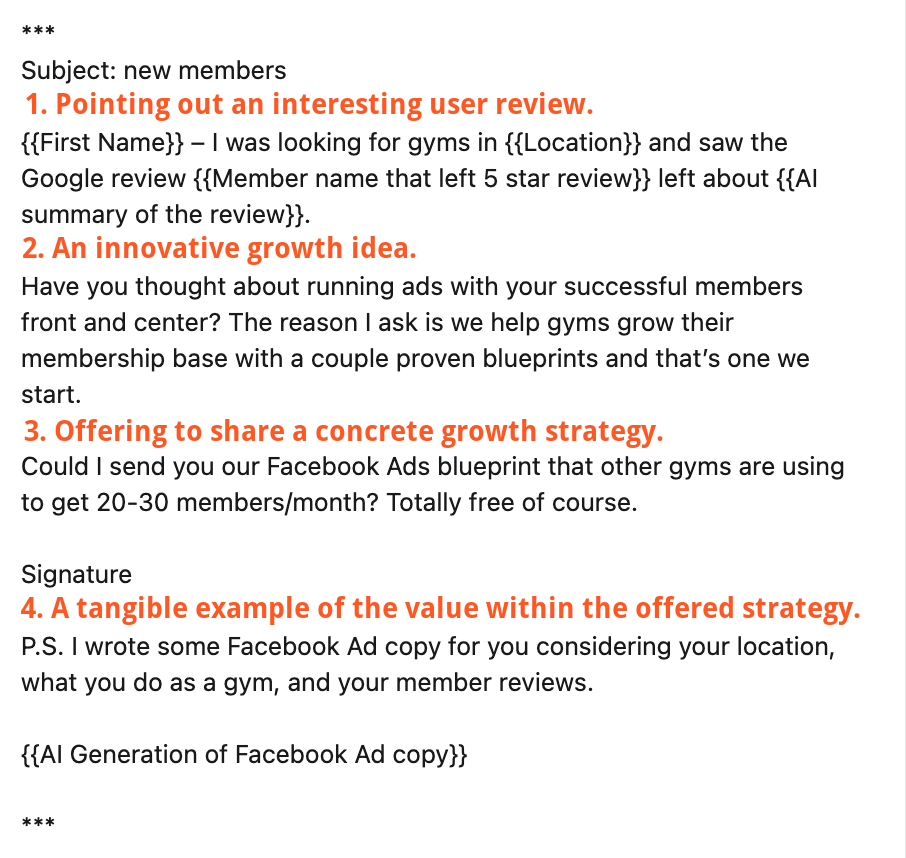
Every paragraph of this email provides some value for the recipient. Not only does it include free tips to be used right away, but it also hints at extra value you can “unlock” by replying.
As long as the campaign’s targeting is accurate, many recipients will simply feel obliged to respond because of the rule of reciprocity!
Meaningful
Finally, your objective for the cold email campaign has to be meaningful for your business.
In most cases, sending a cold email and getting a positive reply is only the journey's first step.
Responding to your message needs to put your recipient on track to the full conversion that you’re hoping for, whether it’s a sale or establishing a business relationship.
One example I like citing is a type of campaign that I received dozens of times while working at an SEO agency.
The email was short:
As you can imagine, this gets a very high response rate because agencies are always looking for new clients. The problem is you’re making the recipient think you’re interested in their services while it’s the other way around!
Even if this message gets you replies, it’s not putting the recipient into the right funnel. On the contrary, it’s confusing and off-putting once they realize they’re being tricked.
Here’s an example of the opposite:
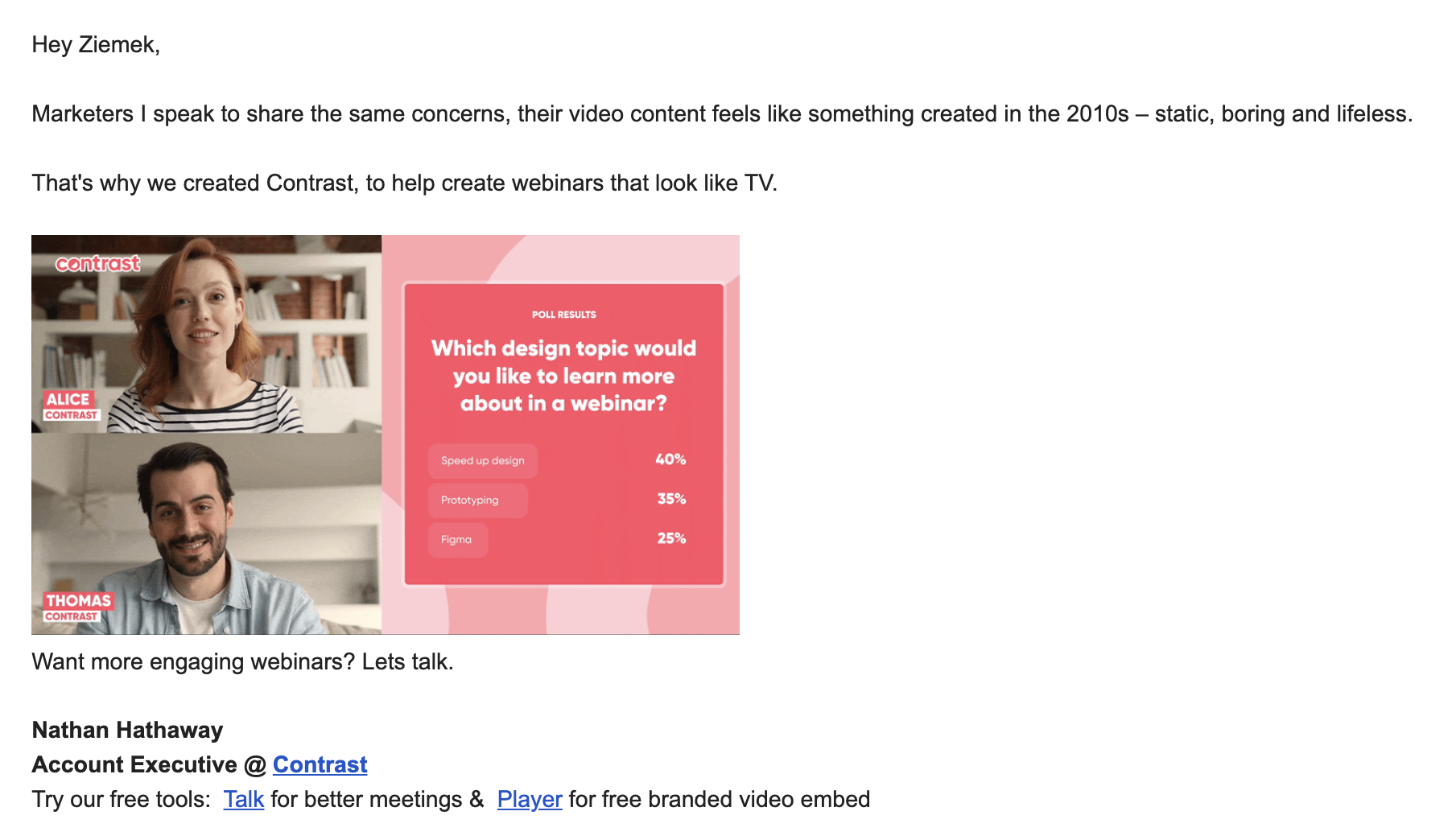
This email is meaningful because its objective is aligned with the broader business purpose: it builds awareness and opens up a conversation to drive the adoption of a product. I know exactly what I can expect from the sender if I decide to reply.
Applying WARM
You can use the following set of questions to define WARM goals for your campaigns:
- What do I want to achieve? I want to build links from high-authority, relevant websites, so I must find editors willing to publish our guest posts.
- Who is my audience? Editors of websites that mention email outreach and have a Domain Rating of 60+.
- What is my goal? I’m asking if they are interested in publishing my guest post with a link to my website.
- What do I offer in return? A year of free access to our product.
- How will I measure success? A minimum of 10% reply rate from editors who will accept our guest posts or suggest an alternative solution that will get us the link.
If you answer these questions well, your campaign will be:
- Well-defined (you’ve established clear tactics and success criteria),
- Achievable (your CTA is appropriate for the cold email channel),
- Reciprocal (you’re offering something of great value in return),
- Meaningful (if you succeed, you’ll be on the right track to achieving your overarching business purpose.)
WARM: Before and after
Let’s try to apply this framework and WARM up an email campaign I received a while back.
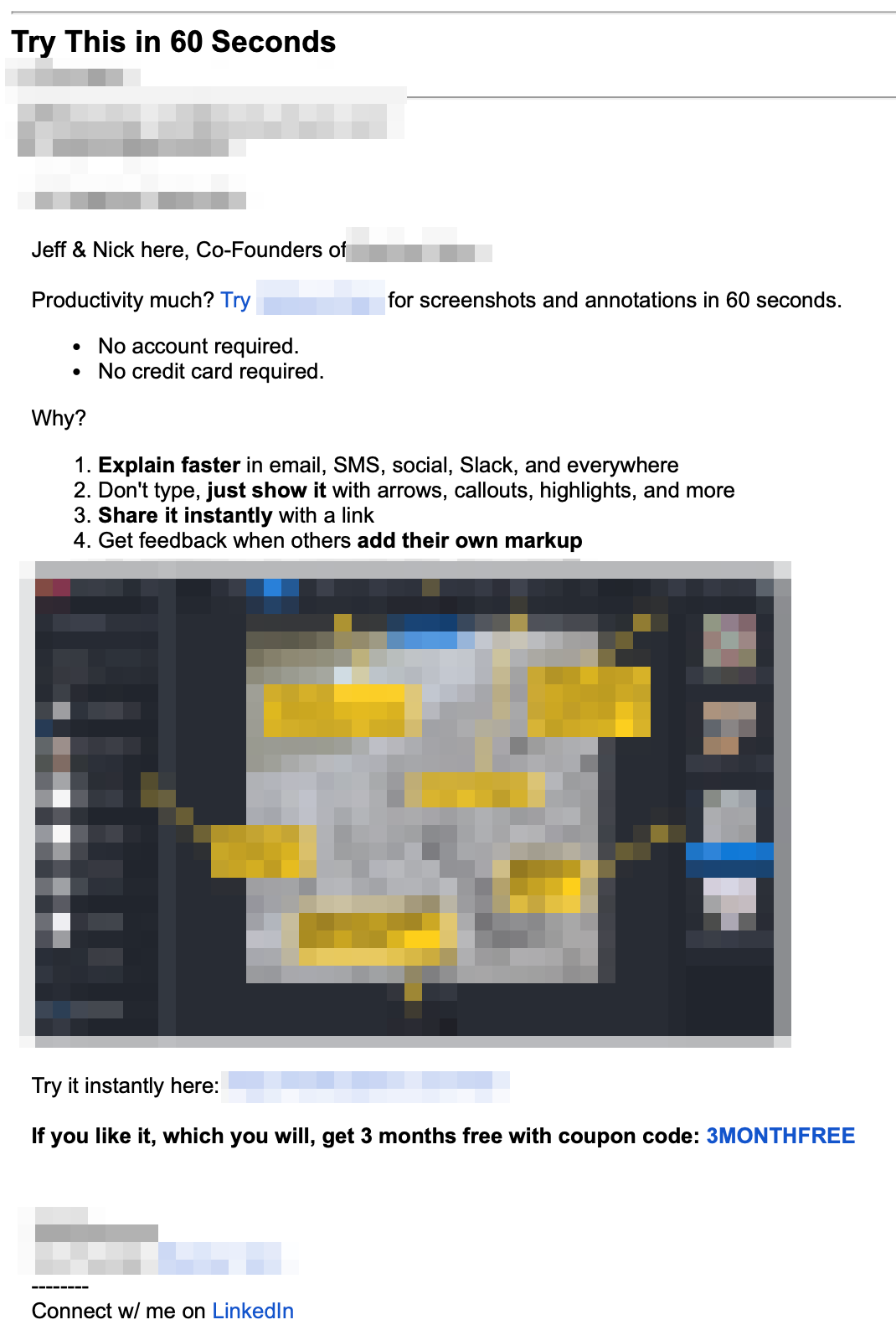
This email stands out to me because I don’t see a clear goal, or at least not one that’s appropriate for a cold email:
- It’s not well-defined: There are three CTAs (two links and a coupon code to use). Is the goal for me to check out the tool or to create an account?
- It’s not achievable: I’m presented with a multitude of features, and with my low initial level of trust and interest, I feel overwhelmed. Furthermore, the email is signed with two different names, which makes it harder to establish any personal connection.
- It’s not reciprocal: I don’t feel the value for me in using the tool. With so many features presented, it feels more like I’m supposed to test the tool. “Try This in 60 Seconds” is not a promise of any value to me – even if it lasts 5 seconds, I’m not getting anything back.
- It’s not meaningful: In my view, it’s not clear whether this email is supposed to generate awareness, link clicks, or new accounts. It feels more like a display ad than a personalized message.
Let’s try and fix it using the WARM template! First, let’s set a clear objective.
- What do I want to achieve? I want to encourage buyers in the B2B SaaS industry to use the demo of my productivity tool and get people to reply positively. Then, I’ll follow up with the recipients who converted.
- Who is my audience? Decision makers in B2B SaaS companies with fewer than 30 employees (because these teams will be more willing to adapt a new cost-effective tool), and they’re currently using Loom, but they aren’t fully satisfied (I can find them by scraping reviews with less than 5 stars on G2, Trustpilot, etc.)
- What is my goal? I’m asking if they want one month of access for their team to decide if they can benefit from using my tool.
- What do I offer in return? Free month of access for 10 team members, pointing out Loom’s shortcomings and suggesting a better solution.
- How will I measure success? A minimum of 10% clickthrough rate.
Now that my objective is WARM, let’s write the email!
Hi <<first name>>,
Are you still using Loom to share videos with your team?
Asking cause I share your frustration with <<scraped personal frustration with Loom>>.
I created a better alternative: you can record up to 15 minutes on a free plan, the price/seat is over 50% lower than Loom, and both Mac and Windows users are thrilled with the performance.
I'll be happy to give you and 10 other team members a free month of premium.
Sounds good?
Ziemek
Why is this better?
The process of refining my goal made everything else easier:
- It was simpler to come up with ideas for finding my prospects,
- My targeting determined the type of value I should provide and made it easier to write the copy,
- Personalization was a by-product of finding recipients,
- In the process, I discovered relevant differentiators between my product and the alternative.
If you don’t like the WARM framework, feel free to use something else. But ensure you set a great objective before moving on to the next steps of creating your campaign!
Next steps
With the Value Proposition Canvas ready and your campaign objective WARMed up, it’s time for the final strategic element: what should your cold email sequence look like to maximize positive replies?

